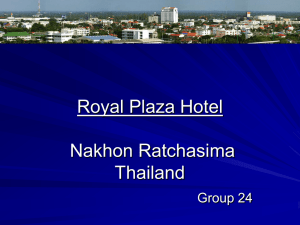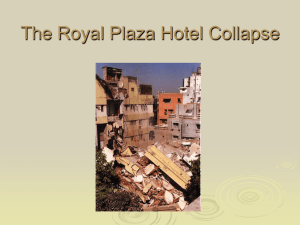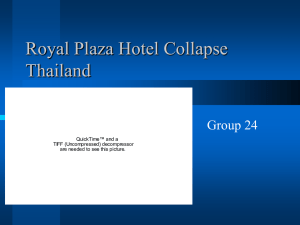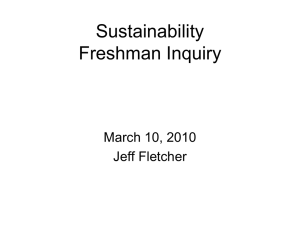comparative assessment of collapse safety of reinforced
advertisement
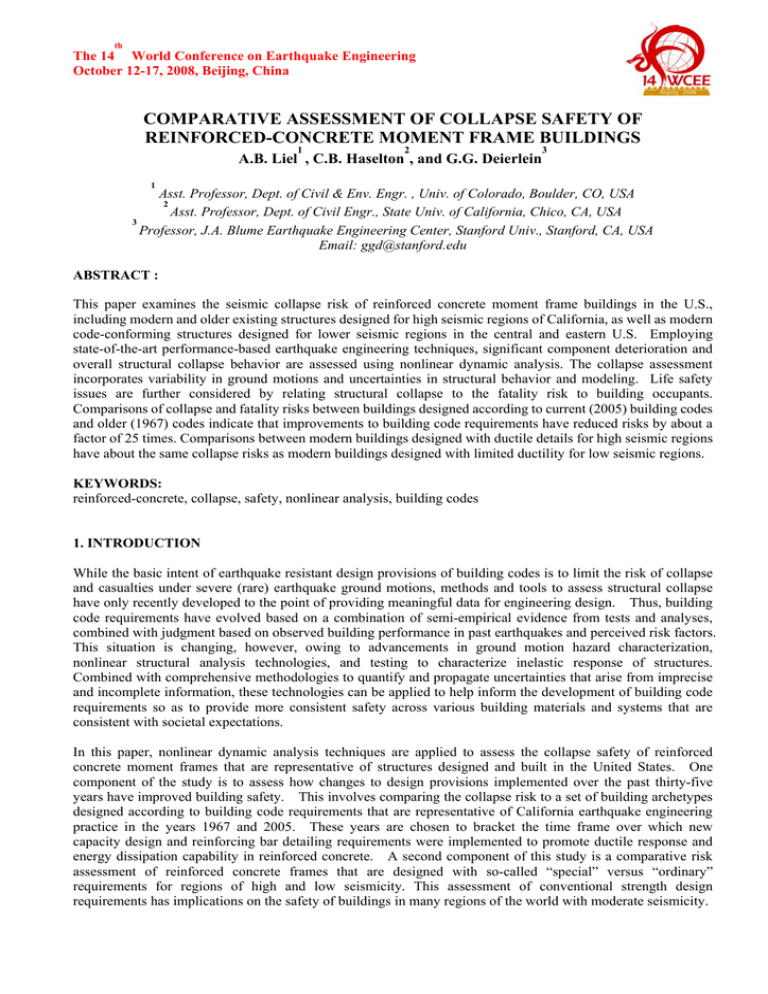
th The 14 World Conference on Earthquake Engineering October 12-17, 2008, Beijing, China COMPARATIVE ASSESSMENT OF COLLAPSE SAFETY OF REINFORCED-CONCRETE MOMENT FRAME BUILDINGS 1 2 3 A.B. Liel , C.B. Haselton , and G.G. Deierlein 1 Asst. Professor, Dept. of Civil & Env. Engr. , Univ. of Colorado, Boulder, CO, USA 2 Asst. Professor, Dept. of Civil Engr., State Univ. of California, Chico, CA, USA 3 Professor, J.A. Blume Earthquake Engineering Center, Stanford Univ., Stanford, CA, USA Email: ggd@stanford.edu ABSTRACT : This paper examines the seismic collapse risk of reinforced concrete moment frame buildings in the U.S., including modern and older existing structures designed for high seismic regions of California, as well as modern code-conforming structures designed for lower seismic regions in the central and eastern U.S. Employing state-of-the-art performance-based earthquake engineering techniques, significant component deterioration and overall structural collapse behavior are assessed using nonlinear dynamic analysis. The collapse assessment incorporates variability in ground motions and uncertainties in structural behavior and modeling. Life safety issues are further considered by relating structural collapse to the fatality risk to building occupants. Comparisons of collapse and fatality risks between buildings designed according to current (2005) building codes and older (1967) codes indicate that improvements to building code requirements have reduced risks by about a factor of 25 times. Comparisons between modern buildings designed with ductile details for high seismic regions have about the same collapse risks as modern buildings designed with limited ductility for low seismic regions. KEYWORDS: reinforced-concrete, collapse, safety, nonlinear analysis, building codes 1. INTRODUCTION While the basic intent of earthquake resistant design provisions of building codes is to limit the risk of collapse and casualties under severe (rare) earthquake ground motions, methods and tools to assess structural collapse have only recently developed to the point of providing meaningful data for engineering design. Thus, building code requirements have evolved based on a combination of semi-empirical evidence from tests and analyses, combined with judgment based on observed building performance in past earthquakes and perceived risk factors. This situation is changing, however, owing to advancements in ground motion hazard characterization, nonlinear structural analysis technologies, and testing to characterize inelastic response of structures. Combined with comprehensive methodologies to quantify and propagate uncertainties that arise from imprecise and incomplete information, these technologies can be applied to help inform the development of building code requirements so as to provide more consistent safety across various building materials and systems that are consistent with societal expectations. In this paper, nonlinear dynamic analysis techniques are applied to assess the collapse safety of reinforced concrete moment frames that are representative of structures designed and built in the United States. One component of the study is to assess how changes to design provisions implemented over the past thirty-five years have improved building safety. This involves comparing the collapse risk to a set of building archetypes designed according to building code requirements that are representative of California earthquake engineering practice in the years 1967 and 2005. These years are chosen to bracket the time frame over which new capacity design and reinforcing bar detailing requirements were implemented to promote ductile response and energy dissipation capability in reinforced concrete. A second component of this study is a comparative risk assessment of reinforced concrete frames that are designed with so-called “special” versus “ordinary” requirements for regions of high and low seismicity. This assessment of conventional strength design requirements has implications on the safety of buildings in many regions of the world with moderate seismicity. th The 14 World Conference on Earthquake Engineering October 12-17, 2008, Beijing, China 2. COLLAPSE ASSESSMENT METHODOLOGY The conceptual framework for the collapse assessment process, shown in Figure 1, is derived from a more general framework for performance-based earthquake engineering developed by the Pacific Earthquake Engineering Research (PEER) Center (e.g., see Deierlein 2004). The process begins with characterization of the seismic hazard, which is typically described by spectral acceleration intensity at the first-mode period of the structure. For assessment by nonlinear dynamic analyses, a set of ground motions is selected and scaled to represent ground motion hazards of increasing intensity. Structural response is evaluated using nonlinear dynamic analysis and described through demand parameters such as story drift, member forces and deformations, and floor accelerations. When the nonlinear analysis accounts for all significant modes of deterioration, then the collapse limit state can be assessed directly by excessive (runaway) deformations. Otherwise, the collapse is indirectly assessed through collapse limit state checks of individual components. While preferable to assess collapse directly by analysis, the indirect approach is more prevalent in practice owing to the limitations of analysis software to capture strength and stiffness degradation. For example, indirect collapse (collapse prevention) assessment by static nonlinear (pushover) analysis is used for the evaluation of existing buildings in ASCE 41 (2007), FEMA 356 (2000), and ATC 40 (1996). More recent initiatives, such as the ATC 63 (2008) project to assess seismic response factors and the ATC 58 (2008) project on performance-based design, are emphasizing direct assessment of collapse using nonlinear dynamic analysis. This paper focuses on direct assessment methods that are augmented, where necessary, by indirect assessment. Decision Variable DV: COLLAPSE Damage Measure DM: Sudden Loss of Component Capacity EDPs: Deformations & Forces Engineering Demand Parameter EDP: Interstory Drift Ratio Intensity Measure IM: Sa(T1) + Ground Motions Figure 1. Process Flowchart for Performance-Based Engineering 2.1. Deterioration Modes and Collapse Scenarios Direct assessment of collapse begins with a careful assessment of the various modes of deterioration in the structural components that make up a structure and how these may combine to form collapse mechanisms. For example, in reinforced concrete moment frames, the primary structural components of the seismic force resisting system are the beams, beam-columns, beam-column joints, and column foundations. Deterioration of beam-columns may be associated with flexural hinging, axial compression, shear, or a combination of these. While modern seismic design provisions seek to minimize the potential for certain of these deterioration modes through capacity design and ductile detailing provisions, to the extent that the deterioration modes are possible they must be accounted for either directly in the analysis or indirectly through component limit state checks. Direct collapse assessment generally requires structural component models that can simulate likely modes of strength and stiffness degradation that occur at large deformations. For example, shown in Figure 2 are the key attributes of a concentrated hinge model by Ibarra et al. (2005) that the authors have employed for simulating the inelastic response of reinforced concrete beam-columns. The plot of moment versus rotation in Figure 2b represents the initial monotonic loading response where the key attributes necessary for collapse analysis are the plastic rotation capacity, Θpl, prior to the onset of softening and the post-peak degrading slope. This initial monotonic backbone curve is integrated into a cyclic model that accounts for inelastic strength and stiffness th The 14 World Conference on Earthquake Engineering October 12-17, 2008, Beijing, China degradation (Figure 2c). As described by Ibarra et al. (2005) and Haselton et al. (2007), the instantaneous backbone curve degrades as a function of the cyclic loading and thus can accurately simulate the response under different loading histories. This attribute is important for collapse assessment, where the inelastic loading involves just a few large cycles prior to collapse, which are different from the symmetric cyclic loading history that is commonly employed in component tests. 300 Θpl Experimental Results Model Prediction Shear Force (kN) 200 Θ 100 0 -100 -200 -300 -0.1 -0.05 0 0.05 0.1 Column Drift (displacement/height) (a) (b) (c) Figure 2. Illustration of modeling components for reinforced concrete beam-column, (a) inelastic hinge model, (b) monotonic backbone curve, and (c) cyclic response model. 2.2 Idealized Analysis Models for RC Moment Frame Archetypes For the purposes of assessing the performance of a class of structural system types, as opposed to the performance of a specific building, idealized analysis models are created to represent the essential features of the system archetypes. As shown in Figure 3a, the archetype analysis model for the RC moment frames used in this study consists of a three-bay multi-story frame that incorporates nonlinear models for beams, beam-columns, beam-column joints and foundation bases. The three-bays are the minimum number necessary to capture significant design features associated with interior versus exterior columns and beam-column joints. The model includes a “leaning column” to represent the destabilizing P-Δ effects of the gravity loads that are stabilized by the moment frame. Shown in Figure 3b are typical examples of the calibrated monotonic backbone curves corresponding to beam-columns with ductile (special) and non-ductile (ordinary) detailing. Normalized Moment [M/My] 1.6 Typical ductile column backbone Typical non-ductile column backbone 1.4 1.2 1 0.8 θcap θpc 0.6 0.4 Note: The column properties given are for the interior 1st story column in a 4-story space frame. 0.2 0 0 0.05 0.1 0.15 Chord Rotation (rad) 0.2 (b) (a) Figure 3. Key elements of nonlinear analysis (a) three-bay archetype analysis model and (b) representative backbone curves for RC beam-columns 2.3 Collapse Assessment and Spectral Shape Adjustment for Nonlinear Dynamic Analysis Owing to the highly nonlinear dynamic response of structures to earthquake ground motions, evaluation of structural collapse by nonlinear dynamic analysis requires statistical evaluation of response for multiple ground motions. As shown in Figure 4a, a common way for visualizing the dynamic analysis results is through an Incremental Dynamic Analysis (IDA) plot, where each point represents the peak response (story drift) from a time history analysis and each curve represents multiple response points for an individual ground motion. The point where each plot becomes horizontal is the collapse intensity for that ground motion. The ground motion intensity on the vertical axis is the ground motion spectral acceleration at the first-mode elastic response period th The 14 World Conference on Earthquake Engineering October 12-17, 2008, Beijing, China of the structure. For example, the solid black line plot in Figure 4 is for a ground motion with a collapse spectral intensity of Sa(T1) = 0.48g. The large scatter in the plots is referred to as record-to-record variability and is due to variations in frequency content and pulse effects of the records, mode effects, and inelastic softening of the structure. The collapse intensity points generally fit a log-normal distribution, which is characterized by a median and dispersion. For the example in Figure 4, the median collapse based on 44 (22 pairs) of ground motions is Sa(T1) = 0.26g with a dispersion σ(ln(Sa))= 0.39. Shown in Figure 4b is a cumulative distribution of the collapse data, which is convenient for relating spectral intensity to the probability of collapse. Collapse of modern code-conforming buildings generally occurs under large spectral intensities associated with rare ground motions. For example, building codes in the United States require that buildings have a low chance of collapse under Maximum Considered Earthquake (MCE) motions with recurrence intervals on the order of 2500 years (2% chance of exceedence in 50 years). Baker and Cornell (2005) have shown that these rare ground motions have unique spectral shapes, which tend to peak at certain periods and drop off at longer and shorter periods. As a result, when scaled based on the spectral acceleration of the fundamental vibration of the structure, these peaked ground motions are less damaging to the structure. In Figure 4a, the records that collapse the structure at higher intensities (and hence are less damaging) tend to be motions that have peaked spectral shapes close to the natural building period (T1 = 2.2 seconds in this example). (a) (b) Figure 4 – Incremental Dynamic Analysis results for an 8-story non-ductile reinforced concrete moment frame designed for a region of moderate seismicity (Liel 2008) Baker and Cornell (2005) further show that the spectral shape effect can be characterized by a parameter called “epsilon” of the ground motion record, which describes the variation of the spectral intensity of the record from the mean value of spectral intensity predicted by attenuation functions used in seismic hazard analysis. Epsilon is a property of the ground motion at the period of interest. Regression studies between epsilon and the collapse intensity show how the collapse intensity tends to be larger for records with positive epsilon values. The relationship between epsilon and collapse intensity is important, since the ground motions that dominate the rare earthquake ground motion intensities at a given period will tend to have positive values of epsilon. Therefore, unless the record set used for the IDA is carefully screened to all have positive epsilon values, they will tend to underestimate the structural collapse intensity. A practical alternative to the formidable task of choosing records with the correct target epsilon is to adjust the collapse median using regression relationships between the epsilon and collapse intensity values. Studies of this epsilon (spectral shape) effect for the ATC 63 project (ATC-63 2008) show that depending on the site hazard characteristics (that define the target epsilon) and the structural ductility, this adjustment can result in increases of up to 65% in the median collapse intensity. 2.4 Incorporation of Non-Simulated Collapse Limit States As noted previously, deterioration modes of structural components that can trigger collapse but are not th The 14 World Conference on Earthquake Engineering October 12-17, 2008, Beijing, China accounted for in the nonlinear analysis model must be incorporated through limit state checks based on demand parameters. In reinforced concrete moment frames, this situation may arise, for example, with column shear failures and column axial failure following shear failure that can trigger collapse and are difficult to model directly in analysis. Elwood and Moehle (2005) and Aslani (2005) have developed models to predict column shear failure and subsequent axial failure as a function of column drift, axial load, and tie reinforcement details. For columns that are not specifically detailed to avoid shear failures and loss of confinement, these models predict shear failures for story drift ratios in the range of 0.01 to 0.05 and axial failures in the range of 0.01 to 0.09. In studies by the authors of non-ductile space frames of 4 to 8 stories, these models predict shear failures at drift ratios of 0.019 to 0.017 and axial failures at drift ratios of 0.038 to 0.032 (Liel 2008). Once the component limit state demand parameter limits are known, one must decide to what extent this component limit state impacts overall collapse. In the case of column shear failure or axial failure, it is reasonable (albeit conservative) to assume that the first exceedence of these limit states in any one story to be a collapse critical condition. Shown in Figure 5 is an example of how the column limit states are incorporated into the nonlinear dynamic analysis. Essentially, the IDA results for each ground motion are checked against the limit state, and if exceeded, the limit state will control the collapse intensity for that record (e.g., the collapse spectral intensity for the highlighted plot in Figure 5a is reduced from Sa = 0.48g to Sa=0.42g). When this check is made for all ground motions, the net result is a reduction in the median collapse intensity. The three plots in Figure 5b are for cases corresponding to sidesway collapse alone (as simulated directly from analysis), critical combinations of sideway collapse or column shear failures, and critical combinations of sidesway collapse or axial column failure. In this particular case, the collapse definition associated with column shear failure results in a significant reduction (about 50%) in the collapse intensity, whereas the definition based on axial column failure is only slightly reduced from the simulated sidesway collapse. The changes in collapse capacity depend on the relative value of the sidesway collapse story drift, as calculated in the time history analyses, and the limit state drifts of the other failure modes. (a) (b) Figure 5. Illustration of modifications to incorporate “Non-Simulated” collapse limit states for an RC moment frame: (a) IDA with adjustment for axial column collapse, and (b) collapse capacity CDFs. 2.5 Characterization and Propagation of Uncertainties Beyond the variation in collapse capacity due to record-to-record uncertainties, other sources of uncertainty in assessing the collapse of either individual buildings or a class of building types include those associated with (a) design decisions and quality assurance, (b) knowledge and quantification of strength and stiffness deterioration from test data, and (c) robustness and accuracy of the nonlinear analysis model. Liel et al. (2008) have investigated rigorous Monte-Carlos response surface simulation methods for characterizing and incorporating some of these uncertainties into the analysis. Liel et al.’s study of collapse in reinforced concrete moment frames suggests that the additional dispersion introduced by modeling uncertainties is equal to σ(ln(Sa)) = 0.5. Assuming the modeling uncertainty to be independent from record-to-record uncertainty, the resulting th The 14 World Conference on Earthquake Engineering October 12-17, 2008, Beijing, China dispersions can be combined using square root of the sum of the squares. Thus, for the example of Figure 4, the record-to-record uncertainty of σRTR = 0.39 increases to a total uncertainty of σTOT = 0.63. Given the limited data available to characterize the many sources of underlying uncertainties, ultimately the uncertainty analysis relies upon a fair amount of judgment. Based in part on theoretical work by Liel et al. (2008) and others, together with systematic judgments regarding the sources of uncertainties, the ATC 63 project employs a method whereby the dispersion in the collapse capacity is estimated based on judgments as to the three sources of uncertainty noted above. When combined with an assumed record-to-record uncertainty of σRTR = 0.4, the ATC 63 procedures indicate total values of uncertainty ranging from a low of σTOT = 0.55 to a high of σTOT = 1.20. The high value corresponds to evaluation of classes of buildings where there is a very high degree of variability (σ = 0.65) in all three sources of uncertainty. 3. COMPARATIVE ASSESSMENTS OF RC MOMENT FRAME ARCHETYPES The collapse assessment methodology described in the previous section can be used to evaluate the collapse safety of individual buildings or more generally the collapse safety of classes of buildings that are designed and constructed according to common building code requirements. The latter studies are conducted by evaluating the performance of archetype buildings with attributes that embody the key design parameters and features of buildings of a certain type. The following is a summary of two such archetype studies. 3.1. Older Non-ductile (1967) versus Modern Ductile (2005) RC Moment Frames Following the 1971 San Fernando earthquake, significant changes were made to design requirements for RC moment frame buildings. These included (a) capacity design provisions to reduce the likelihood of story mechanisms and shear failures in beams, columns and joints, and (b) more stringent reinforcing bar detailing requirements to provide concrete confinement and full strength development lengths for tension reinforcement. While these changes are known to improve the ductility and energy dissipation capacity of frames, the improvement to building collapse capacity and safety to occupants have not been quantified. Questions as to the relative collapse safety are important both to further refinements and improvements to building codes and to policy questions related to retrofit of existing non-ductile concrete buildings. To address these questions, the authors have designed and evaluated a set of archetype moment frame buildings designed according to the 1967 Uniform Building Code (ICBO 1967) and the 2005 ASCE 7 and ACI 318 provisions for a typical building site in coastal California. The study included sixteen designs of 2, 4, 8 and 12 story buildings with both 3D space frame and perimeter frame configurations. The collapse assessment was carried out using the models and concepts discussed previously. Overall, the design base shear force requirement is similar for the older and modern designs. The main difference is that the modern designs have about two to three times the deformation capacity of the older systems. Complete details of the designs and assessment are documented by Liel (2008). Summarized in Table 1 are the collapse and fatality risk safety for the sixteen designs. Of the data reported in Table 1, the following performance metrics are most relevant to assessing the relative performance: (a) P[C/MCE] – the probability of collapse at the MCE ground motion intensity, (b) λcollapse – the mean annual frequency of collapse, which is obtained by integrating the collapse fragility functions (e.g., Figure 4b) with an earthquake hazard curve for coastal California, (c) EANF – the expected annual number of fatalities, obtained by calculating the fatality risk due to building collapse for the assumed number of building occupants, and (d) Norm EANF – the EANF normalized by the assumed number of building occupants. The P[C/MCE] ranges from 0.04 to 0.19 for the modern buildings versus 0.61 to 0.83 for the older non-ductile buildings. On average, the conditional collapse probability is about 6 times higher for the older buildings (average P[C/MCE] of 0.12 versus 0.75). Arguably, the mean annual frequency of collapse (λcollapse) is a more meaningful collapse risk metric since it considers both the fragility of the building and the likelihood of ground motions of varying intensity. Based on this index, the older buildings have a likelihood of collapse that is about 25 times higher than for the new buildings (average λcollapse of 0.0091 collapses/year for the older buildings versus 0.0003 for the th The 14 World Conference on Earthquake Engineering October 12-17, 2008, Beijing, China modern buildings). Based on the normalized ratio of fatalities, the safety ratio of older to modern buildings is about 21 times (average norm-EANF of 0.021 for the older buildings versus 0.001 for the modern buildings). Table 1 Collapse Performance and Fatality Risk for 1967 and 2005 RC Frames System 2-P 2-S 4-P 4-S 8-P 8-S 12-P 12-S Building Code Margin P[C|MCE] λcollapse x 10-4 Occup. (#pers) EANF (x10-3) Norm. EANF (%) 0.014 1967 UBC 0.85 0.61 47 175 23.7 2005 ASCE 2.19 0.12 3.4 173 1.73 0.001 1967 UBC 0.59 0.81 109 175 40.7 0.023 0.0002 2005 ASCE 3.07 0.04 1 173 0.41 1967 UBC 0.66 0.75 100 350 97.4 0.028 2005 ASCE 2.04 0.13 3.6 346 2.7 0.0008 1967 UBC 0.54 0.91 107 350 62.4 0.018 2005 ASCE 2.56 0.07 1.7 346 1.28 0.0004 1967 UBC 0.49 0.81 135 500 141.2 0.028 2005 ASCE 1.77 0.19 6.3 461 8.33 0.0018 1967 UBC 0.75 0.68 64 500 76.6 0.015 2005 ASCE 2.29 0.09 2.4 461 3.08 0.0007 1967 UBC 0.56 0.83 119 750 191.8 0.026 2005 ASCE 1.84 0.16 5.2 692 9.9 0.0014 1967 UBC 0.83 0.62 50 750 75.5 0.01 2005 ASCE 1.91 0.15 4.7 692 9.38 0.0014 4.2. Ordinary versus Special RC Moment Frames The United States has a wide range of seismicity, ranging from areas with minimal risk to earthquakes up to the high seismic regions of coastal California. In low-seismic regions, current building codes permit the construction of “ordinary moment frames” that are detailed for minimum strength requirements but do not include any of the capacity design or ductile detailing provisions that are required for “special moment frames” used in high seismic regions. The difference in ductility requirements is reflected in the seismic response factors used to determine the design base shear. With respective factors of R=3 for ordinary frames and R=8 for special frames, the inelastic force reduction factor in ordinary frames is less than half that for special frames. Table 2 Collapse Performance for 2005 RC SMF and OMF Frames 2-P 2-S 4-P 4-P 8-P 8-S 12-P 12-S SMF (Dmax) 2.01 OMF (Bmax) 2.29 0.10 0.08 SMF (Dmax) 2.76 0.03 OMF (Bmax) 1.97 0.13 SMF (Dmax) 2.29 0.07 OMF (Bmax) 2.29 0.08 SMF (Dmax) 2.53 0.05 OMF (Bmax) 2.29 0.08 SMF (Dmax) 2.02 0.10 OMF (Bmax) 2.03 0.12 SMF (Dmax) 2.52 0.05 OMF (Bmax) 3.03 0.03 0.06 SMF (Dmax) 2.35 OMF (Bmax) 2.33 0.08 SMF (Dmax) 2.44 0.05 OMF (Bmax) 2.6 0.06 4-P OMF (Cmax) 1.78 0.17 4-S OMF (Cmax) 2.25 0.09 12-P OMF (Cmax) 1.24 0.36 12-S OMF (Cmax) 2.04 0.12 To assess the relative collapse safety of special moment frames in high seismic regions versus ordinary moment frames in low seismic regions, a series of comparative frames were designed and compared. In this study the high seismic region is defined by MCE spectral intensity values of Ss = 1.5g (short period) and S1 = 0.9g (1-second period) that represent seismic design category D in the ASCE 7 standard. The low seismic region has MCE spectral intensity values of Ss = 0.5g and S1 = 0.2g that represent seismic design category B in the ASCE 7 standard. Similar to the 1967/2005 study reported previously, the index frames ranged in height from 2 to 12 stories and included both space frames and perimeter frames. The frames were each designed according to the appropriate ASCE 7 and ACI 318 provisions and assessed using the process described previously. Further details of the designs and assessment are reported by Liel (2008). Results of the study comparing the RC ordinary and special moment frames are summarized in Table 2. Here the primary index to compare is the P[C/MCE], i.e., the probability of collapse at the respective MCE ground motion intensity used th The 14 World Conference on Earthquake Engineering October 12-17, 2008, Beijing, China in the respective designs. Overall, the results shown that the conditional collapse risk are comparable for the ordinary and special frames. The special frames have conditional collapse probabilities that range from 0.03 to 0.10 with an average value of 0.06, and the ordinary frames have probabilities that range from 0.03 to 0.013 with an average of 0.08. To further assess whether ordinary detailing would provide comparable safety in moderate seismic regions, 4and 12-story ordinary frames were designed for a region of moderate seismicity with MCE spectral intensity values of Ss = 0.75g and S1 = 032g that represent seismic design category C in the ASCE 7 standard. As shown in the shaded boxes of Table 2, these designs had larger conditional collapse probabilities, up to 0.36 for the 12-story perimeter frame. Thus, the comparison substantiates the validity of current building code provisions that permit ordinary (limited ductility) frame construction (R=3) only in regions of low-seismicity. 5. CONCLUDING REMARKS AND ACKNOWLEDGMENTS Improved knowledge, models and analysis technologies that permit explicit assessment of collapse risks are emerging as a valuable tool to inform the development of building code policies and requirements for the design of new structures and retrofit of existing buildings. The two application studies to assess the collapse safety of reinforced concrete buildings are offered as examples to illustrate how such collapse assessment techniques can be applied. This work has been supported by the PEER Center through the Earthquake Engineering Research Centers Program of the National Science Foundation (under award number EEC-9701568) and the Applied Technology Council through funding of the ATC-63 project by FEMA. The authors acknowledge and appreciate the constructive contributions of collaborators from PEER and ATC in this study. REFERENCES ACI (2005). Building Code Requirements for Structural Concrete (ACI 318), American Concrete Institute. ASCE-7 (2005). Minimum Design Loads for Buildings and Other Structures, ASCE 7-05. ASCE-41(2007). Seismic Rehabilitation of Existing Buildings, ASCE/SEI 41-06, ASCE Aslani, H. (2005). Probabilitistic Earthquake Loss Estimation and Loss Disaggregation in Buildings, Ph.D., Stanford Unv. ATC-40 (1996) Seismic Evaluation and Retrofit of Concrete Buildings, ATC 40, Applied Technology Council. ATC-63 (2008). Recommended Methodology for Quantification of Building System Performance and Response Parameters, ATC-63 90% Draft. Applied Technology Council, Redwood City, CA. ATC-58 (2007), Guidelines for Seismic Performance Assessment of Buildings, ATC-58 35% Draft, Applied Technology Council, Redwood City, CA. Baker J.W. and Cornell, C.A. (2006) “Spectral shape, epsilon and record selection”, Earthquake Engineering. & Structural Dynamics, 34 (10), 1193-1217. Deierlein, G. G. (2004). "Overview of a Comprehensive Framework for Earthquake Performance Assessment". Proc. Intl. Workshop on Performance-Based Seismic Design. PEER TR 2004/05, pg. 15-26. Elwood, K., Moehle J. (2005). "Drift Capacity of Reinforced Concrete Columns with Light Transverse Reinforcement," Earthquake Spectra, 21(1): 71-89. FEMA 356 (2000), Prestandard and Commentary for the Seismic Rehabilitation of Buildings, Federal Emergency Management Agency. Haselton, C. B. and G. G. Deierlein (2007). Assessing Seismic Collapse Safety of Modern Reinforced Concrete Frame Buildings, PEER TR 2007/08. Haselton, C.B., A.B. Liel, S. Taylor Lange, and G.G. Deierlein (2007). Beam-Column Model Calibrated for Predicting Flexural Response Leading to Global Collapse of RC Frame Buildings, PEER TR 2007/03. Ibarra, L. F., R. A. Medina and H. Krawinkler (2005). "Hysteretic Models that Incorporate Strength and Stiffness Deterioration." Earthquake Engineering and Structural Dynamics 34: 1489- 1511. ICBO (1967). Uniform Building Code. Pasadena, CA. Liel, A. B. (2008). Assessing the Collapse Risk of California’s Existing Reinforced Concrete Frame Structures: Metrics for Seismic Safety Decisions, Ph.D. Thesis, Stanford University. Liel, A. B., C. B. Haselton, G. G. Deierlein and J. W. Baker (2007). "Incorporating Modeling Uncertainties in the Assessment of Seismic Collapse Risk of Buildings." Structural Safety (in press).

